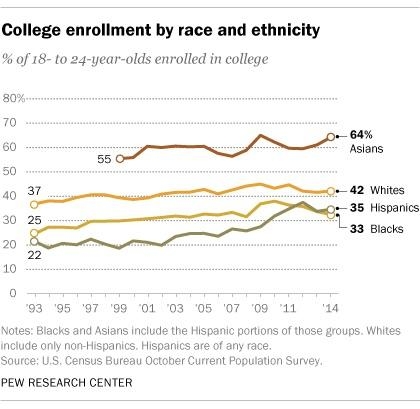Why Higher Education Depends on The Hispanic Market

- Reduced revenue driven by flat/declining enrollment and reduced public funding
- Reduced demand resulting from a shrinking pool of high school students and stagnating household incomes
- Increased questions about the value of a four-year college degree as young people's attitudes change and demand increases for better outcomes
- Technological disruption with the growth of online education, MOOCs (massive open online courses), and other non-traditional forms of education powered by digital technology
These challenges are causing universities, colleges and other education providers to merge, restructure and fundamentally rethink their business models. While many of the changes are likely necessary for the continued viability of higher education, the U.S. Hispanic market is one overlooked bright spot and opportunity.
In many ways, the Hispanic market represents an antidote and counterpoint to the prevailing issues noted above.
Reduced Revenue – Hispanics are seeing significant growth in terms of college enrollment. The number of Hispanic college students in the U.S. reached 3.4 million in 2012, rising from 11% of the U.S. college population in 2006 to over 17%. Hispanic enrollment in colleges, universities and other educational programs is increasing almost across the board.

The Value of a College Education – Hispanics continue to place a high level of importance on education, specifically in the form of traditional four-year college degrees. We have seen consistently across our Hispanic Millennial and Generation Z studies that young Hispanics, regardless of their nativity, diverge from non-Hispanic whites in their positive attitudes and beliefs towards higher education. For instance, 46% of Hispanic Millennials consider graduating from a four-year college as a future goal, compared to only 31% of non-Hispanic Millennials (HMP). Among Gen Z, we see that 67% of Hispanics 11-16 view college as essential, versus only 60% of non-Hispanic whites (We Are Gen Z Report).
The entire higher education industry has a major opportunity and potential “lifeline” with Hispanics. Taking advantage of these opportunities will require more than just simple cosmetic changes to their marketing materials or outreach efforts. To fully take advantage of the Hispanic market, colleges and universities will need to rethink and adjust all elements of their enterprise — from their recruiting to their curriculum, student support, and alumni relations. The lag in Hispanic four-year college completion rates is a testament to the importance of this “all-in” approach. Those that do will be well-positioned to emerge from the current environment as leaders in a new higher education landscape.
Source: Published originally on mediapost.com Why Higher Education Depends On The Hispanic Market by Jose Villa, June 23, 2017